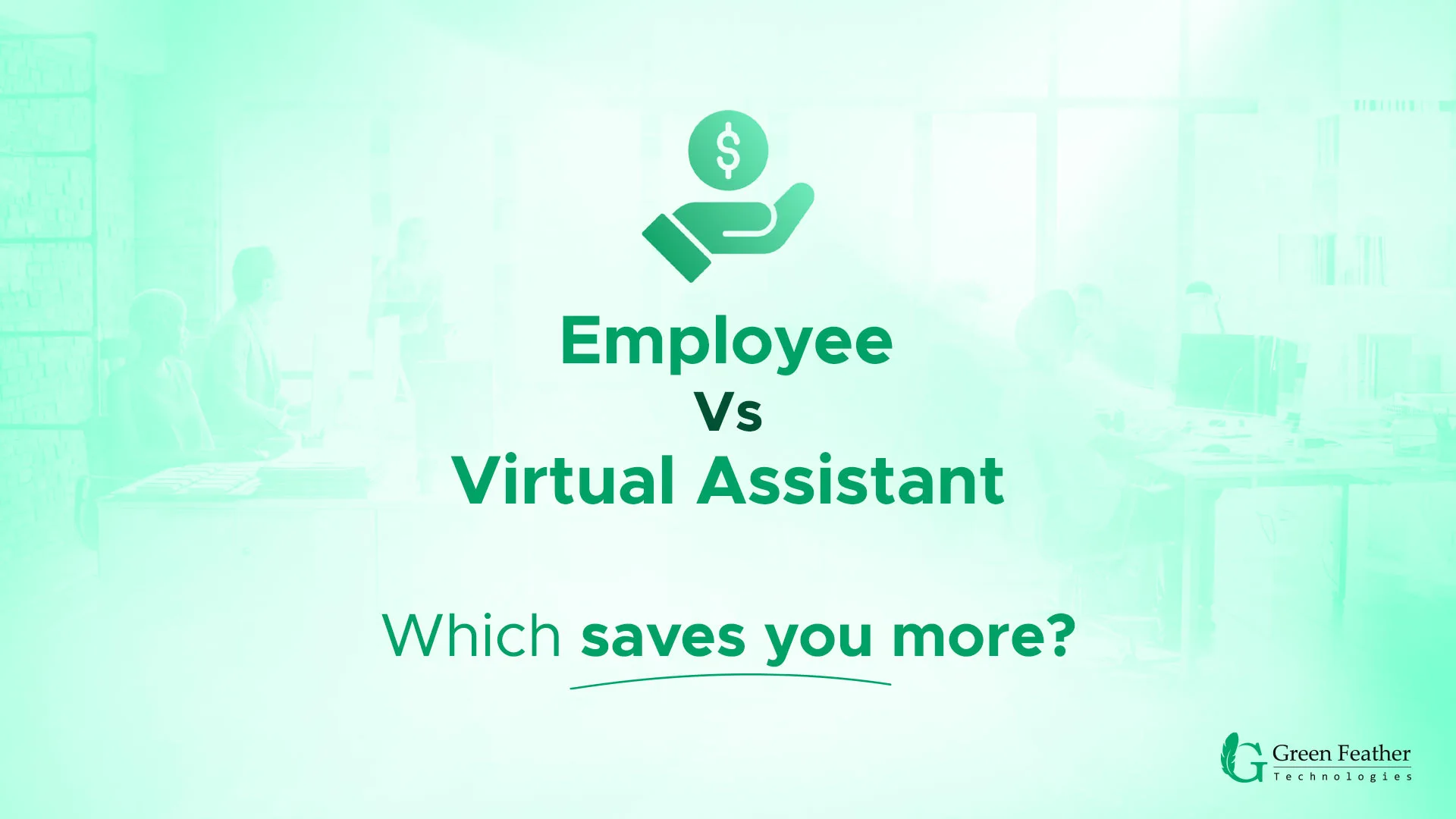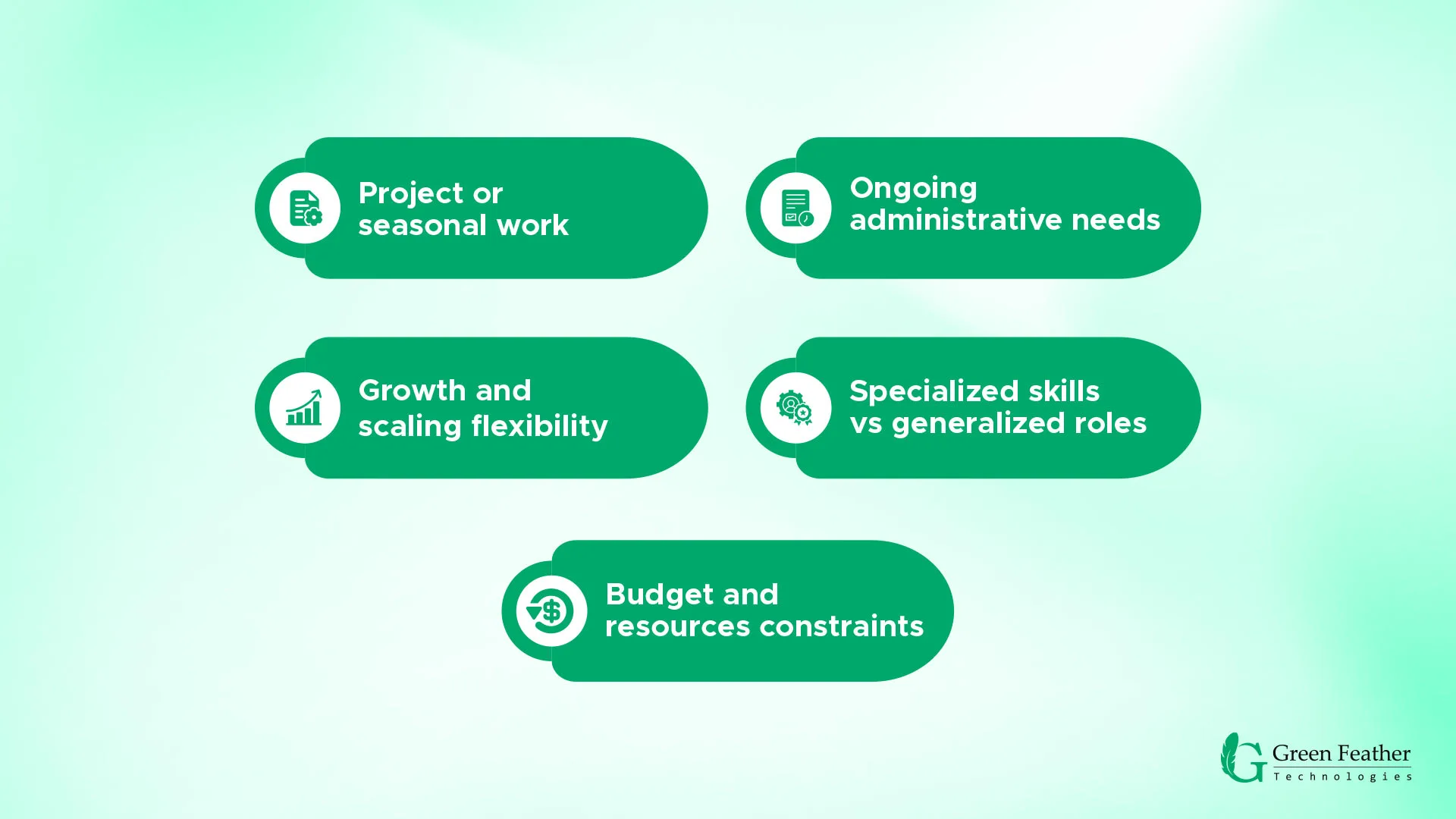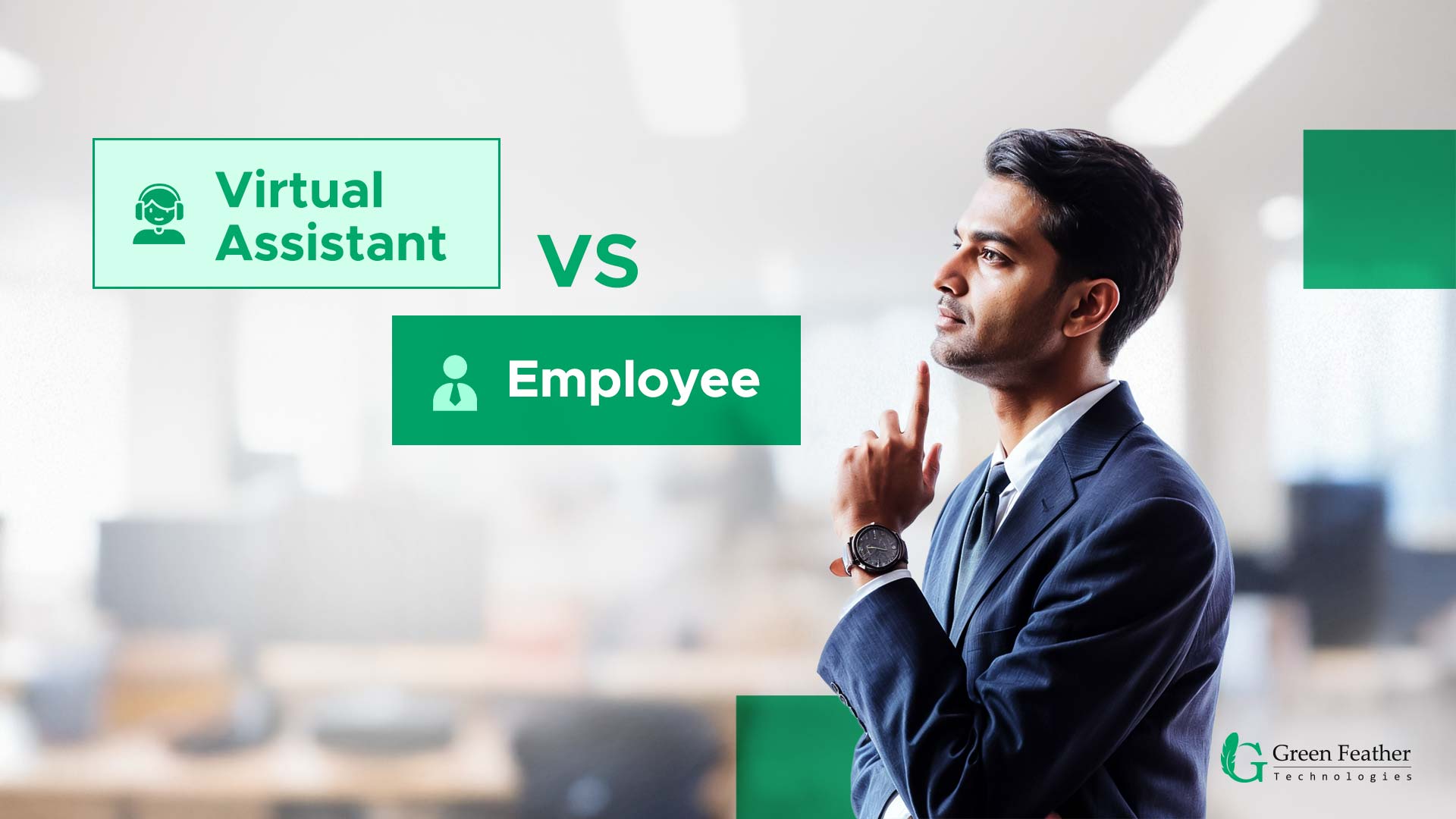As a business owner, you have often asked yourself this question: should I hire a Virtual Assistant, or should I opt for more in-house employees?
The truth is, there are pros and cons to both options: virtual assistant vs employee. Entrepreneurs must understand the details of both to make the best decision for themselves.
In this guide, we will go over the key differences between virtual assistants and employees. We’ll also look at the pros and cons of each option.
Keep reading this comparison guide to find which will be the best fit for you.
Differences - Virtual Assistant vs Employee

So what are the key differences between virtual assistant and employee?
A virtual assistant is a remote professional who offers services on an hourly basis, or as per the requirements of a project. And an in-house employee works full-time in the office and is entitled to benefits. This is just one of the differences.
Let’s go over some important key differences below:
| Key Differences | Virtual Assistant (VA) | Employee |
|---|---|---|
| Employment Status and Hiring Flexibility |
|
|
| Cost Comparison |
|
|
| Work Location and Accessibility |
|
|
| Tasks and Specializations |
|
|
| Time Commitment and Scheduling |
|
|
| Level of Supervision and Management |
|
|
1. Employment Status and Hiring Flexibility
As summarized in the table above, there are key differences in the employment status and hiring flexibility when it comes to virtual assistant vs employee.
i) Differences in Hiring
- Virtual Assistant: Hiring a virtual assistant is quite simple. You can hire virtual assistant services or virtual assistants on sites such as Green Feather Technology, Fiverr, Upwork, or Freelancer.
- Employee: Hiring employees is a longer process. You will have to go through resumes, take interviews, and then select the right fit for the role.
ii) Differences in Legal Obligations
- Virtual Assistant: Virtual Assistants are usually self-employed, freelancers, or independent contractors. So, the business owners have limited legal obligations towards VAs.
- Employee: Employees are entitled to benefits, and they sign a legally binding contract with the company. Therefore, the company is legally responsible for things like taxes, insurance, and protection registration for the employee.
iii) Differences in Flexibility
- Virtual Assistant: Virtual assistants decide their working hours. They are more flexible than employees, as they can rearrange their schedules to fit business needs.
- Employee: Employees are less flexible because once they have signed a contract with you, you are legally obligated to keep the employee until the contract expires or is terminated.
2. Cost Comparison

There is a shocking difference in the cost of virtual assistant vs employee.Let’s take a look at some of the major cost categories below.
i) Differences in Salary
- Virtual Assistant: Virtual assistants are not salaried employees; they have hourly rates or charge a flat fee. Their rates can range anywhere from $20 to upwards of $50/hour. Given that they don’t usually work 40-hour weeks, the ultimate compensations paid to them are fairly low. On average, you’ll have to pay VAs around $1500 monthly.
- Employee: You have to pay employees a fixed amount monthly as per your contract, even if they are not being productive all the time. Since the salaries are paid monthly rather than on an hourly basis, this tends to add up to be much more than what you pay for VAs, often being more than $3000.
ii) Differences in Benefits
- Virtual Assistant: Given that VAs are independent contractors, they are not entitled to any benefits.
- Employee: Employees are entitled to all benefits. Therefore, you will have to pay for fringe benefits such as insurance and 401k while also keeping bonuses and overtime in mind.
iii) Differences in Overhead
- Virtual Assistant: There are no overhead costs associated with VAs given that you don’t have to pay for their housing or transportation. Additionally, you don’t have to rent office spaces to accommodate remote office assistants since they work online!
Employee: There are massive overhead costs associated with employees. Renting office spaces in major cities can be as expensive as $2000/month per employee.
If you interested to get an inexpensive Virtual Assistant, you can be helped with the following article.
Read More: How to Get an Affordable Virtual Assistant
3. Work Location and Accessibility
Virtual assistants work remotely, while employees work in-house. Therefore, there are some differences in work location and accessibility. Let’s break down work location and accessibility for virtual assistant vs employee.
i) Setup Differences
- Virtual Assistant: VAs handle their own office setups. They have their designated workspaces; they pay for their own internet and digital appliances. Virtual assistants buy and use their own laptops, webcams, and other digital apparatus as needed.
Employee: Companies pay for the entirety of their employees office setups, including laptops or desktops, webcams, keyboards, and all other appliances.
ii) Remote Work Differences
- Virtual Assistant: Virtual assistants are often called remote business assistants because they work fully remotely.
- Employee: Unless the company operates in a hybrid manner, employees don’t work remotely and are expected to come to the office as per contract.
iii) In-Office Availability Differences
- Virtual Assistant: Given that remote office assistants are often international, they don’t have in-office availability.
- Employee: Employees have full-time in-office availability unless the company allows work-from-home days.
4. Tasks and Specializations
Virtual assistants can be both generalized and specific. Although the same may apply to employees, generally employees operate within the scope of your company’s operations. Tasks and specializations for virtual assistant vs employee are broken down below:
i) Specialized Virtual Assistant vs Employee
- Virtual Assistant: There are specific VAs who offer industry-specific or project-specific services. There are three main categories of specialized virtual assistants: technical, administrative, and creative. Specialized VAs include social media virtual assistants, real estate virtual assistant, IT virtual assistants, marketing virtual assistants, project management virtual assistants, etc.
- Employee: Specialized employees are generally higher-level employees. These are your managers, team leads, department heads, etc.
ii) General Virtual Assistant vs Employee
- Virtual Assistant: General VAs provide general operational and administrative support to entrepreneurs. Your general VA answers emails, manages schedules, fixes appointments, communicates with clients, etc.
- Employee: Most employees in the company are general employees. They are team members who work in a specific department under supervision and deliver measurable targets for the company.
5. Time Commitment and Scheduling
There are lots of differences between virtual assistant vs employees, with time commitment and scheduling being a major one.
i) Working Hours
- Virtual Assistant: You can hire a part-time virtual assistant or a full-time one. Typically, full-time VAs work 40 hours a week, but they set their working hours. Virtual assistants don’t work from 9:00 AM to 5:00 PM; They set time frames for themselves to work in.
- Employee: Typically, employees work 8 hours a day, from 9:00 to 5:00. They work fixed hours according to company policy.
ii) Working Flexibility
- Virtual Assistant: Virtual assistants work flexibly. They are not bound to work 40 hours a week, although full-time virtual assistants generally do. Virtual assistants decide their schedules and work according to that.
Employee: Employees work on a fixed schedule and don’t generally have the flexibility to choose their working hours.
6. Level of Supervision and Management
All entrepreneurs want what’s best for their company, and that’s often achieved through constant supervision. However, VAs and employees require different levels of supervision from their team leads. Let’s take a look below at virtual assistant vs employee:
- Virtual Assistants: With their prior experience in the industry, VAs don’t require constant micromanagement or supervision. They can deliver excellent results without constant supervision. Experienced virtual assistants require even less management.
Employees: Employees don’t create their own schedules. Business owners, their human resources department, or the supervisors set their working schedule.
Advantages and Disadvantages of Hiring a Virtual Assistant
There are multiple advantages and disadvantages of working with VAs. While they do save costs and are more flexible to work with, they also often show limited commitment or availability. Let’s break the pros and cons working of VA down:
Advantages of Hiring a VA
There are generally four unique advantages when it comes to virtual assistants vs employees.
- Cost Savings: Experienced virtual assistants may charge a lot of money, with some even opting for over $100 hourly. However, those are the most expensive bracket of VAs, with most charging anywhere from $5 to $50. Even if you’re paying your VA $100/hour, you’re still saving a lot of money.Therefore, comparatively, they are much cheaper than employees.
- Flexibility and Scalability: The best part about working with virtual assistants is their flexibility and scalability. If your workload is expanding, VAs can quickly swoop in to help you complete projects faster and deliver deadlines. However, the converse is also true. If your workload is low, you can easily talk to your VAs to reduce their working hours or stop working with them altogether!
- Access to Global Talent: Virtual assistants are remote independent contractors, which means you can hire VAs from all over the world. This unique access to a global talent pool is something you can only get from a person who works remotely.
- Reduced Administrative Responsibilities: We have talked earlier about the fact that remote office assistants need limited supervision. This means you can hand over some responsibilities completely to experts, experience reduced administrative responsibilities, and focus on core business tasks instead.
You can also learn more about to hire a virtual assistant by reading the article mentioned below.
Read More: Why Hire a Virtual Assistant?
Disadvantages of Hiring a VA
There’s no doubt that working with remote office assistants will give you multiple advantages. However, there are also some disadvantages that you should keep in mind before hiring a virtual assistant vs an employee.
- Limited Control: You don’t have full control over your virtual assistant. Given that they require limited supervision, set their hours, and are independent contractors, there’s limited control you have over them compared to employees.
- Potential Communication Gaps: Having a remote worker on your team has its disadvantages. Given that VAs work from different timezones and there are cultural and language barriers between you, it leads to the perfect breeding ground for communication gaps.
- Limited Availability or Loyalty: Employees are loyal to the company, but virtual assistants aren’t contractually obligated to be 100% committed to you or available for you. Therefore, you will find that your remote office assistants aren’t as easily accessible as your employees.
Advantages and Disadvantages of Hiring an Employee
Just like virtual assistants, there are advantages and disadvantages to hiring employees. We’ve broken down some of them below:
Advantages of Hiring an Employee
Employees are the backbone of our economy. There’s a reason most companies globally are employee-based.
- Dedicated Commitment: Employees are fully available for you and dedicated to you. They will be there full-time, for 40 hours, and they will dedicate themselves to your company and nowhere else.
- Easier Team Building: Since you have easy access to your employees, it’s easy to build teams with them. Additionally, there are no cultural or language barriers for the most part. Therefore, employees have an easier time assimilating with the company.
- Full-time Availability: Virtual assistants can be part-time, but employees are generally full-time. They don’t set their own schedules; they work according to company schedules. This means they have full-time availability for you at all times.
- Stronger Accountability: Employees are legally bound to your company, which means there are stronger accountability mechanisms in place for your company.
Disadvantages of Hiring an Employee
We also need to talk about the disadvantages that employees pose to a company for a fair assessment.
- Higher Costs: At first glance, it may seem in the virtual assistant vs employee debate that you pay both the same amount of money. However, employees are entitled to benefits, bonuses, overtime, and PTOs. This makes them more expensive compared to virtual assistants.
- Long-term Commitment: You can’t reduce employee numbers because your company has a lower workload at any given moment. Employees are there for the long term; therefore, it’s a long-term commitment to keep working with them!
- Potential for Office Space and Resources Costs: You have to pay for office space, wifi, setups, and all other essentials for employees to work in-house.
When to Hire a Virtual Assistant vs Employee

The burning question now is, how do you know when you should hire a virtual assistant vs employee? Let’s outline situations where you should hire a virtual assistant vs when you should hire an employee.
i) Project or Seasonal Work
- Virtual Assistants: If your company is taking on a project for a finite amount of months or you are experiencing a seasonal spike, it makes more sense to hire a virtual assistant. Virtual assistants are designed to work at times of high crisis and can offer immediate support in times of spikes.
- Employee: However, if you are looking at a long-term project that will take at least a year to complete, it’s best to go with a full-time employee. This is the more stable option.
ii) Ongoing Administrative Needs
- Virtual Assistants: Virtual assistants can handle routine tasks on a need basis.
- Employee: However, if you need to handle daily administrative work in the office full-time, it’s best to go with an employee.
iii) Growth and Scaling Flexibility
- Virtual Assistants: VAs are best for supporting businesses that are undergoing rapid changes. If you are scaling up rapidly and need immediate support, you should hire a virtual assistant as soon as possible. This fast-paced growth is the perfect place for virtual assistants to come in.
- Employees: However, if your company is experiencing structured, slow, predicted growth, then it’s best to create a strong team of full-time employees. Employees are the long-term solution for structured, steady growth.
iv) Specialized Skills vs Generalized Roles
- Virtual Assistants: VAs are perfect for specialized, specific, niche tasks. For instance, you can hire virtual assistants for event planning or project management. These are specific tasks that require a specialized set of skills.
- Employees: Employees, on the other hand, are more useful for handling core administrative tasks, and core business duties.Therefore, you need to decide depending on whether you need a more specialized skillset at your disposal, or you are looking for someone who can work with you long term.
v) Budget and Resources Constraints
- Virtual Assistants: If you are experiencing budget or resource constraints, and are trying to save up on costs, it’s best to opt for a virtual assistant. Remote assistants don’t require office space, have their setup, and will save you lots of money.
- Employees: If you do have the budget to have an office space, and don’t have any resource constraints at the moment, you should hire employees.
Key Takeaways to Choose Virtual Assistant vs Employee
We hope you’ve gotten your answer to the virtual assistant vs employee debate. Let’s summarize everything we have learned so far so you can make the best decision for yourself. The things you need to consider before deciding to hire an employee or virtual assistant are:
- Evaluate Business Needs and Objective
- Consider Cost and Budget
- Assess Workload and Project Frequency
- Factor in the Required Level of Control and Supervision
- Determine Skills and Experience Requirements
- Assess Team Culture and Long-term Goals
- Long-term vs Short-term Needs
You can get more information to hire a VA by reading the mentioned article below.
Read More: How to Hire a Virtual Assistant?
Conclusion
To summarize the virtual assistant vs employee debate: like all things, there is no one clear-cut answer. It all comes down to your business needs. Whether you choose an employee or virtual assistant will depend on your budget, goals, and experience required.
There is no right answer to this debate, only the right answer for you. We hope we’ve helped you make the right decision for yourself!
FAQs
Can a virtual assistant replace a full-time employee?
Virtual assistants and employees are in different positions. While virtual assistants can do all the tasks employees can, they are usually better for short-term projects.
What skills should I look for in a virtual assistant?
Your virtual assistant should have to be an expert in the field you are looking for.
What is the biggest challenge to hiring a virtual assistant?
Finding reliable virtual assistants in your budget who can also work in a similar timezone is the biggest challenge.
Which is best for small businesses: a virtual assistant or an employee?
A virtual assistant for small and medium businesses is best if you are working on a resource and budget constraint.
What are the tax implications of hiring a virtual assistant vs. an employee?
You are not responsible for VA taxes, but you are responsible for your employees.
Can virtual assistants work on specialized industry tasks?
Yes, there are specialized industry virtual assistants who offer specialized services.
Do virtual assistants have the same level of accountability as employees?
Generally, employees are more accountable than virtual assistants because of legal obligations.
Which option is better for customer support: virtual assistant vs employee?
That completely depends on what kind of customer support you need! Both VAs and employees are able to provide excellent customer support.
Can a virtual assistant be as reliable as a full-time employee?
Virtual assistants are reliable, but full-time employees are generally more committed because they work full-time. They are legally bound to the company. Therefore, they are generally more accountable.



